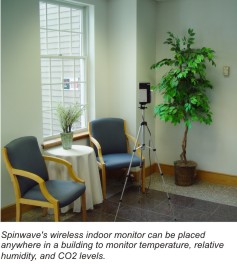December 2008
![]()
AutomatedBuildings.com
[an error occurred while processing this directive]
(Click Message to Learn More)
December 2008 |
[an error occurred while processing this directive] |
|
|
 Christina Inge |
If you’re getting requests to conduct an indoor air quality audit, you’re not alone. Monitoring indoor air quality (IAQ) is a top issue for many in the automation field. It is a key component to LEED certification for existing buildings, as well as a major concern for building occupants. But if you’re just looking at standard IAQ measures like airborne particulates, you may be missing important clues about what’s really causing an air-quality problem. You may also be missing out on data that could improve your building’s overall performance, even save energy costs.
|
|
|
|
|
|
|
|
|
|
|
|
|
|
|
|
|
|
|
|
|
[an error occurred while processing this directive] |
Why? Problems with indoor air quality often stem from the same cause as problems with energy usage, so if you’re seeing IAQ issues in a building, energy efficiency issues are probably there, too. Occupant comfort issues are almost certainly present, also. IAQ is part of an interrelated picture, along with energy efficiency and occupant comfort. The three are linked together, and you can only fully understand your IAQ picture if you closely examine it in the context of your building’s comfort and efficiency measures. So if you are conducting an indoor air quality audit, expanding your audit to include energy and comfort variables can lead to cost savings and improved building performance.
In its most basic form, an IAQ audit measures the substances in indoor air that affect the occupants, such as CO2, volatile organic compounds (VOCs), and mold. Yet measuring only those substances is only part of what a comprehensive IAQ audit should be. Done right, an IAQ audit can be paired with an energy audit to give you a complete picture of how well your building is performing overall.
Indoor air quality is part of the overall occupant comfort picture, along with temperature and humidity. Measuring all three factors together helps you truly understand how well your building is performing in terms of comfort. Occupants can, after all, find a building uncomfortable even when the air is good-quality, if temperatures or humidity are not well-controlled.
It also makes sense to measure all three factors because both temperature and humidity directly impact the quality of indoor air. High levels of humidity contribute to the growth of mold, one of the single largest causes of poor IAQ. The US EPA recommends RH levels of no more than 60% (30% is better) to prevent mold growth. Temperature also impacts IAQ: according to ASHRAE’s Guideline 10, keeping temperatures low can reduce occupant complaints in buildings where IAQ, though acceptable, is not ideal, since particles will circulate less in cooler air.
If you are conducting an IAQ audit, it makes sense to conduct an energy audit concurrently. Examining both IAQ and efficiency gives you the whole picture of how your building is performing. This whole picture gives you far more actionable data that you can use to improve your building’s performance. For example, an IAQ audit alone will tell you whether your CO2 levels in your building are too low, indicating an over-ventilated building. A comprehensive energy audit can help:
• pinpoint the potential source of the problem
• provide you with solid energy usage numbers that show the monetary cost of the inefficient system
• provide you with temperature and humidity measurements that quantify the loss of occupant comfort
Measuring your HVAC system’s energy consumption can also provide early indications of mechanical problems that will lead to IAQ issues. If your building has packaged rooftop units, measuring the units’ primary energy consumption is an excellent early-warning system of issues that effect both energy use and IAQ. Normally, any large rise or drop in an RTU’s energy use results from a problem that is directly related to IAQ, such as dampers being left open, or failing to open. Energy efficiency is thus closely tied to IAQ—measuring both is the ideal way to make sure your building is functioning optimally.
[an error occurred while processing this directive] Wireless Sensors Provide a Cost-Effective Way to Monitor IAQ, Occupant Comfort, and Energy Efficiency
Wireless sensors provide a cost-effective, efficient way to conduct IAQ audits, or combined IAQ and energy efficiency audits. A wireless sensor can simply be placed anywhere in a building where you need to measure CO2, temperature, humidity, or VOCs, and moved as needed to take measurements throughout the building. With wireless, conducting an audit is no longer a costly undertaking, nor does it require lengthy installations of equipment, which can disrupt occupants. Spinwave’s wireless field kit, for instance, can simply be placed anywhere in a building where monitoring is needed, and will wirelessly transmit CO2, temperature, and humidity measures to a central receiver—there is no need to install any devices, and no need to run wires. Wireless systems have truly made conducting IAQ audits easier.
Wireless Sensors for Continuous IAQ Monitoring
Although conducting an audit is the first step in a comprehensive plan for improving IAQ, you will need to measure IAQ factors continuously if you want lasting results. In addition, having permanent monitoring in place is needed to obtain certain LEED points. Continuous monitoring is especially important in regions with four seasons, with significant fluctuations in temperature and humidity. An audit conducted in the winter can produce results that differ in important ways from conditions you’ll have in your building over the summer. Thus, it is important to maintain some level of continuous monitoring in your building throughout the year, in addition to conducting a thorough audit.
Once an audit is complete, wireless sensors can be installed permanently to continue tracking IAQ measurements. Because wireless devices are easy to install, you can have more nodes per building at a low cost, providing you with data from more points inside your building.
As indoor air quality remains a growing concern for facilities managers, it’s important to conduct building audits with a view towards the whole picture, so that you can truly get actionable insights for improving the quality of your indoor air. Whether you are pursuing LEED certification, want to correct a problem, or just want to create a more productive, sustainable building environment, looking at your total IAQ picture will pay great dividends.
About Spinwave Systems Wireless Sensors and Pulse Counters for IAQ and Energy Monitoring
 •
Field Kit: Spinwave’s wireless field kit allows you to conduct IAQ and
energy usage audits cost-effectively, with minimal investment in equipment and
quick setup times. The Field Kit consists of:
•
Field Kit: Spinwave’s wireless field kit allows you to conduct IAQ and
energy usage audits cost-effectively, with minimal investment in equipment and
quick setup times. The Field Kit consists of:
• An indoor monitor with CO2, temperature, and relative humidity sensors. Mounted on a tripod, the indoor monitor can be placed anywhere in a building where these variables need to be measured, and transmits data wirelessly to a receiver, allowing data to be collected remotely.
• A pulse counter in a NEMA4X weatherproof enclosure, for measuring electricity or gas usage at the meter level and transmitting data to the central receiver.
• A receiver with USB adapted for collecting indoor monitor and pulse counter data and downloading it to a laptop. The receiver can also integrate the field kit with your existing automation system, for monitoring data through your BAS interface.
• Wireless Pulse Counters: Spinwave
Systems’ Pulse Counters enable you to monitor energy consumption, including
primary energy consumption by rooftop units. Pulse counters are used to
wirelessly transmit meter values (accumulated pulses and pulses per time) and
make them available as BACnet, LON or Modbus variables using Spinwave’s BMS
Protocol Interface or as digital outputs (pulse replication) using a BMS I/O
Interface. Pulse Counters can be battery or line-powered. A set of 6 D-Cell
batteries will last for up to 8 years.
• Wireless Sensors: Wireless temperature and relative humidity sensors
are battery-powered, with an available optional power supply. Temperature
sensors are available as plain sensors, with override, or with set-point. Also
available is a combined temperature and RH sensor.
For more information, visit http://www.spinwavesystems.com, or contact Spinwave Systems directly at 978-392-9000, ext. 225 or info@spinwavesystems.com
About the Author
Christina Inge is the marketing manager for Spinwave Systems, Inc., a leader
in developing wireless sensors and controls for the energy management and
building automation markets. She can be reached at
cinge@spinwavesystems.com.
[an error occurred while processing this directive]
[Click Banner To Learn More]
[Home Page] [The Automator] [About] [Subscribe ] [Contact Us]